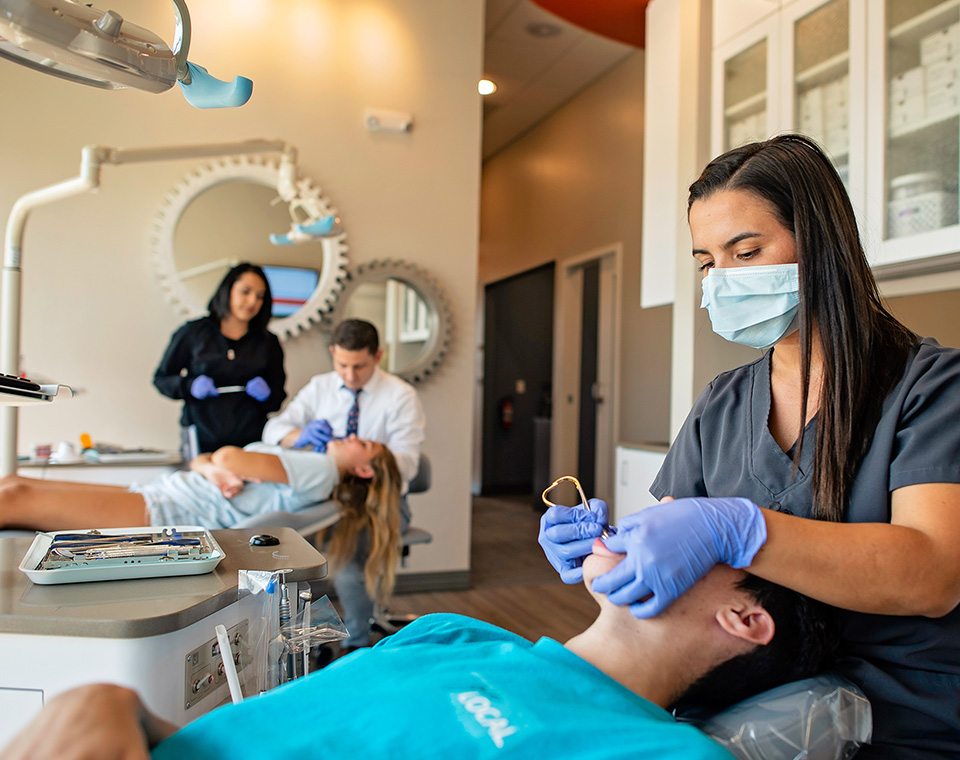Why is Oral Hygiene Important to Avoid Periodontal Disease During Orthodontics?

Enid Orthodontic treatment’s popularity among adults is skyrocketing. The influence of access to verified information about its importance and the effect of social media seems to have a powerful impact on prospective patients.
A study conducted in the UK in 2019 revealed a 75% increase in patients ages 26 to 55 seeking orthodontic treatment. Today more and more adults Google orthodontic options.
But how do these intentions relate to one patient’s condition, and how can they determine the successful completion of the orthodontic plan? In other words, orthodontic treatment improves the patient’s quality of life, and we encourage them to go for it, but we must first look at the gums’ periodontal health.
To clarify this point, there is an increased tendency to develop periodontal diseases as we grow. In fact, approximately 40% of adults over 30 years old have some form of periodontal disease.
This article discusses periodontal disease, popularly known as gum disease, and its relationship with treating malocclusion. In addition, we pinpoint oral health implications as a condition to start orthodontic treatment.
The Importance of Good Oral Hygiene During Orthodontic Treatment
Enid Orthodontic treatment with braces might impact a patient’s oral hygiene. Moreover, orthodontic patients have a significant propensity to develop tooth decay and gum disease if they don’t adapt to their new condition.
Enhanced oral hygiene measures are crucial to reducing to zero the possibility of developing gum disease during orthodontic treatment. Here we give you some tips:
Brushing
We must address the question about how to Brush Your Teeth With Braces Properly. Use a little toothpaste to identify problematic spots, reach all possible areas, and spend an extra minute brushing each of the arches. Then, stop, make a visual check, and repeat. Remember to brush after meals.
Flossing
Flossing with a floss threader won’t help much. Instead, try asking your dentist for the appropriate size of interdental brushes. These tiny little instruments are tremendously helpful in reaching entrenched spots.
If you don’t feel sure and want to go a little further, use a water irrigator to complement your flossing routine. This device will help you unclog food particles, splashing a stream of water to the spots that are challenging to clear.
Mouthwash
We have visited mechanical ways to remove food and debris, but they wouldn’t do much if it weren’t for bacteria that decompose them into nasty acidic residues. So, it would be best to kill bacteria to the best possible using mouthwash for braces users.
Dental Check-ups
Finally but not least important are the check-ups. Regardless of how good your oral hygiene routine is, plaque accumulates no matter what. So, we recommend patients visit a dentist at least twice a year for professional cleanings.
Following these recommendations guarantees a smooth braces treatment, Enid, nulling the possibility of developing gum disease. Now that we have discussed prevention, we must dig into the problem.
These recommendations are excellent forms of maintaining good oral hygiene with traditional braces, self-ligating, and ceramic braces Enid, but what about patients wearing Invisalign clear aligners?
How Often Should You Clean Invisalign?
Patients wearing Invisalign might practice their regular hygiene routine. However, if wanted, they might apply the advice for braces users, but they might not, by any chance, forget to clean up their Invisalign trays.
Patients wearing Invisalign might brush their appliances with a soft-bristled toothbrush and liquid soap after every meal and disinfect the guards at night.
Here we list some of the products you can use to sanitize your Invisalign trays:
- Invisalign cleaning crystals
- Retainer Brite
- Baking soda
- Vinegar
- Hydrogen peroxide
What Is Periodontal Disease?
Before describing periodontal disease, we must discuss its levels, starting from Gingivitis. Indeed addressing it requires understanding how it develops in the first place.
What Is Gingivitis?
Gingivitis is inflammation, redness, and mild bleeding of the gums. It occurs as an effect of poor dental hygiene. You have it right; if you skip brushing and flossing or do not follow our advice for braces users we defined previously, you might end up with Gingivitis.
The good news is you can fix this problem on your own. Resume good oral hygiene, and the inflammation will eventually recede. However, if you neglect this advice, Gingivitis might advance to other, more dangerous, and complex treatment levels of gum disease. Here we describe all of them.
Periodontitis Level 1 – Initial
Any periodontitis, even in its first levels, is dangerous because it is destructive. Any prolonged inflammation can destroy the fibers that help join the roots to the socket.
Unfortunately, the symptoms of Periodontitis Level 1 don’t differ from those of Gingivitis which might lead to letting it pass untreated. Patients with Periodontitis Level 1 can’t solve the problem at home and must seek immediate dental care.
Periodontitis Level 2 – Moderate
The main differentiating factor between level 1 and level 2 is the damage it inflicts on the periodontal ligaments, gum tissue, and bone. The damage is irreversible but still treatable by a specialist.
Periodontitis Level 3 – Severe With Potential Tooth Loss
Level 3 damage is severe enough to cause more than permanent damage to the oral structure, leaving teeth loose. In this stage, a patient might lose their teeth.
This damage is severe, the gums recede, making the tooth look longer, and patients experience bad breath, infections, and abscesses. A patient might be referred for surgery; in some cases, teeth might need replacement with implants.
Periodontitis Level 4 – Severe Gum Disease With Potential Damage of the Oral Structure and All Teeth Loss.
At this level, the infection is so critical that it could spread to other organs and cause a heart attack or diabetes. In most cases, patients have advanced to a point where they have already lost many of their teeth, and those remaining are wiggling in the fragile gums that can’t sustain them.
What Causes Periodontal Disease?
Bacteria accumulation is the cause of periodontal disease. Bacterial plaque accumulates into a rigid structure named calculus or tartar that sticks to the lower párt of teeth near the gums spreading and affecting them, eating away the gum and the tooth.
What causes bacteria accumulation? The answer is poor oral hygiene that is sometimes accompanied by risk factors such as:
- Crooked Teeth
- Hormonal changes in women
- Smoking
- Diabetes
- Stress
- Heredity/genetics
- Immuno deficiencies
- Defective fillings
- Medication
- Not fitting bridges
How To Treat Gingivitis?
For prevention, patients must follow the previous recommendation in this article’s first part. If you notice one of the following warning signs that are symptoms of gum disease, you must visit a dentist immediately:
- Tender gums
- Inflamed and puffy gums
- Dark red gums
- Mild bleeding
- Bad breath
- Receding gums
Failure to address one or more warning signs might result in Gingivitis.
How To Treat Periodontitis?
Periodontists are the only qualified specialists to treat periodontitis. A periodontist might recur to several options and work with other specialists to treat the issue according to the level of damage.
Periodontitis Level 1
Coaching to improve the oral hygiene technique and debridement to clean and remove bacteria and calculus from plaque build-up from the gums and the teeth roots.
Periodontitis Level 2
A periodontist might proceed with a deeper debridement, a prescription of antibiotics, and follow-up check-ups.
Periodontitis Level 3
The damage is so profound that the patient might have bone loss damage and needs periodontal surgery that might include implanting grafts of bone and soft tissue.
Periodontitis Level 4
For some patients, the only option would be corrective treatment to eliminate bacteria, prevent an infection from spreading, and refer the patient for dental implants.
Can You Get Braces if You Have Periodontal Disease?
Gums disease should not prevent patients from receiving orthodontic treatment. But, as you might infer, orthodontics is about moving teeth, and the strain produced by braces might be too much in a patient with a gum issue.
Therefore we must be cautious before anticipating if a patient could have braces with gums disease, and we could say that it is not impossible, but it might require a lot of surveillance and control.
Digging a little deeper, a patient with gingivitis might receive braces but must work with a dentist and have control check-ups to clear it quickly. Patients suffering from level 1 and 2 periodontitis might have to have a clearance from a periodontist before getting braces.
Can You Get Braces If You Have Receding Gums?
Receding gums is usually evident at level 2 periodontitis. This means the level of damage is profound, but after treatment, the periodontist might recover the structure of the gums so they can firmly hold moving teeth.
This means you might be a candidate for braces only after a periodontist clearance, and your orthodontist might opt for a gentle displacement treatment.
Having the Right Information Is Crucial for Succesful Orthodontic Treatment
Recommending Enid braces or Invisalign clear aligners implies a responsibility for an orthodontist’s specialist. This is why they spend years obtaining knowledge and training about how to safely and effectively move your teeth so you have a healthy and beautiful smile.
Consequently, professionals must provide high-quality information to patients so they can make an informed decision about treatment when a condition like periodontitis interferes the way.
Dr. Ryan Williams will ensure you have full clearance before starting orthodontic treatment Enid, so you can rest assured you are in good professional hands. Set up an appointment or call us at (580) 540-3211; our kind staff will be glad to serve you with a heartwarming welcome to our offices for the smile of your life.


